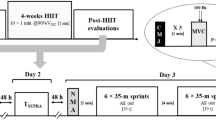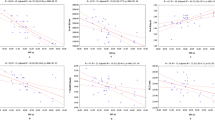Abstract
Purpose
Anaerobic efforts are commonly required through repeated sprint during efforts in many sports, making the anaerobic pathway a target of training. Nevertheless, to identify improvements on such energetic way it is necessary to assess anaerobic capacity or power, which is usually complex. For this purpose, authors have postulated the use of short running performances to anaerobic ability assessment. Thus, the aim of this study was to find a relationship between running performances on anaerobic power, anaerobic capacity or repeated sprint ability.
Methods
Thirteen military performed maximal running of 50 (P50), 100 (P100) and 300 (P300) m on track, beyond of running-based anaerobic sprint test (RAST; RSA and anaerobic power test), maximal anaerobic running test (MART; RSA and anaerobic capacity test) and the W′ from critical power model (anaerobic capacity test).
Results
By RAST variables, peak and average power (absolute and relative) and maximum velocity were significantly correlated with P50 (r = −0.68, p = 0.03 and −0.76, p = 0.01; −0.83, p < 0.01 and −0.83, p < 0.01; and −0.78, p < 0.01), respectively. The maximum intensity of MART was negatively and significantly correlated with P100 (r = −0.59) and W′ was not statistically correlated with any of the performances.
Conclusion
MART and W′ were not correlated with short running performances, having a weak performance predicting probably due to its longer duration in relation to assessed performances. Observing RAST outcomes, we postulated that such a protocol can be used during daily training as short running performance predictor.
Similar content being viewed by others
References
Angius L, Olla S, Piras F, Mura R, Ibba G, Todde F, Cominu M, Pinna M, Tocco F, Concu A, Crisafulli A (2013) Indexes of physical capacity and repeated sprint ability of young soccer players. Sport Sci Health 9:1–6
Balčiūnas M, Stanislovas S, Abrantes C, Sampaio J (2006) Long term effects of different training modalities on power, speed, skill and anaerobic capacity in young male basketball players. J Sports Sci Med 5:163–170
Bangsbo J, Michalsik L, Petersen A (1993) Accumulated O2 deficit during intense exercise and muscle characteristics of elite athletes. Int J Sports Med 14:207–213
Beck WR, Zagatto AM (2009) Mensuração da aptidão aeróbia através dos testes de 12 minutos e velocidade crítica após oito semanas de treinamento aeróbio em militares. Rev Educ Fís 144:23–29
Bosquet L, Duchene A, Lecot F, Dupont G, Leger L (2006) V max estimate from three-parameter critical velocity models: validity and impact on 800 m running performance prediction. Eur J Appl Physiol 97:34–42
Buchheit M (2012) Repeated-sprint performance in team sport players: associations with measures of aerobic fitness, metabolic control and locomotor function. Int J Sports Med 33(3):230–239
Bull AJ, Housh TJ, Johnson GO, Rana SR (2008) Physiological responses at five estimates of critical velocity. Eur J Appl Physiol 102:711–720
Cipryan L, Gajda V (2011) The influence of aerobic power on repeated anaerobic exercise in junior soccer players. J Hum Kinet 28:63–71
Dal Pupo J, Arins FB, Antonacci Guglielmo LG, Rosendo da Silva RC, Moro AR, Dos Santos SG (2013) Physiological and neuromuscular indices associated with sprint running performance. Res Sports Med 23:124–135
Dekerle J, Sidney M, Hespel MJ, Pelayo P (2002) Validity and reliability of critical speed, critical stroke rate, and anaerobic capacity in relation to front crawl swimming performances. Int J Sports Med 23:93–98
Dietz V, Schmidtbleicher D, Noth J (1979) Neuronal mechanisms of human locomotion. J Neurophysiol 42:1212–1222
Driller MW, Argus CK, Shing CM (2013) The reliability of a 30 second sprint test on the Wattbike cycle ergometer. Int J Sports Physiol Perform 8:379–383
Duffield R, Dawson B, Goodman C (2004) Energy system contribution to 100-m and 200-m track running events. J Sci Med Sport 7:302–313
Gastin PB, Costill DL, Lawson DL, Krzeminski K, McConell GK (1995) Accumulated oxygen deficit during supramaximal all-out and constant intensity exercise. Med Sci Sports Exerc 27:255–263
American College of Sports Medicine (1986) Guidelines for graded exercise testing and exercise prescription, 3rd edn. Lea & Febiger, Philadelphia, p 186
Gwacham N, Wagner DR (2012) Acute effects of a caffeine–taurine energy drink on repeated sprint performance of American college football players. Int J Sport Nutr Exerc Metab 22:109–116
Hill DW, Smith JC (1994) A method to ensure the accuracy of estimates of anaerobic capacity derived using the critical power concept. J Sports Med Phys Fit 34:23–37
Hobara H, Inoue K, Gomi K, Sakamoto M, Maraoka T, Isso S, Kanosue K (2010) Continuous change in spring-mass characteristics during a 400 m sprint. J Sci Med Sport 13:256–261
Jenkins DG, Quigley BM (1991) The y-intercept of the critical power function as a measure of anaerobic work capacity. Ergonomics 31:1413–1419
Keir DA, Thériault F, Serresse O (2013) Evaluation of the running-based anaerobic sprint test as a measure of repeated sprint ability in collegiate level soccer players. J Strength Cond Res 27:1671–1678
Lima MCS, Ribeiro LFP, Papoti M, Santiago PRP, Cunha SA, Martins LEB, Gobatto CA (2011) A semi-tethered test for power assessment in running: a semi-tethered test for power. Int J Sports Med 32:529–534
Maxwell NS, Nimmo MA (1996) Anaerobic capacity: a maximal anaerobic running test versus the maximal accumulated oxygen deficit. Can J Appl Physiol 21:35–47
Meckel Y, Machnai O, Eliakim A (2009) Relationship among repeated sprint tests, aerobic fitness, and anaerobic fitness in elite adolescent soccer players. J Strength Cond Res 23:163–169
MedbØ JI, Tabata I (1993) Anaerobic energy release in working muscle during 30 s to 3 min of exhausting bicycling. J Appl Physiol 75:1654–1660
Monod H, Scherrer J (1965) The work capacity of a synergic muscular group. Ergonomics 8:329–338
Noordhof DA, de Koning JJ, Foster C (2010) The maximal accumulated oxygen deficit method: a valid and reliable measure of anaerobic capacity? Sports Med 40:285–302
Nummela A, Alberts M, Rijntjes RP, Luhtanen P, Rusko H (1996) Reliability and validity of the maximal anaerobic running test. Int J Sports Med 17:97–102
Nummela A, Hamalainen I, Rusko H (2007) Comparison of maximal anaerobic running tests on a treadmill and track. J Sports Sci 25:87–96
Nummela A, Rusko H, Mero A (1994) EMG activities and ground reaction forces during fatigued and non-fatigued sprinting. Med Sci Sports Exerc 26:605–609
Papoti M, Zagatto AM, Freitas Júnior PB, Cunha AS, Martins LEB, Gobatto CA (2005) Utilização do intercepto-y na avaliação da aptidão anaeróbia e predição da performance de nadadores treinados. Rev Bras Med Esporte 11:126–130
Perroni F, Corvino M, Cignitti L, Minganti C (2013) RSA response to preseason training in semiprofessional soccer players. Sport Sci Health 9:59–64
Rusko H, Nummela A, Mero A (1993) A new method for the evaluation of anaerobic running power in athletes. Eur J Appl Physiol Occup Physiol 66:97–101
Spencer MR, Gastin PB (2001) Energy system contribution during 200- to 1500-m running in highly trained athletes. Med Sci Sports Exerc 33:157–162
Wakayoshi K, Yoshida T, Udo M, Harada T, Moritani T, Mutoh Y, Miyashita M (1993) Does critical swimming velocity represent exercise intensity at maximal lactate steady state? Eur J Appl Physiol Occup Physiol 66:90–95
Zacharogiannis E, Paradisis G, Tziortzis S (2004) An evaluation of tests of anaerobic power and capacity. Med Sci Sports Exerc 36:116
Zagatto A, Redkva P, Loures J, Kalva Filho C, Franco V, Kaminagakura E, Papoti M (2011) Anaerobic contribution during maximal anaerobic running test: correlation with maximal accumulated oxygen deficit. Scand J Med Sci Sports 21:e222–e230
Zagatto AM, Beck WR, Gobatto CA (2008) Comparison among the critical velocity determined by three conventional models and anaerobic threshold in running. Int J Exerc Sci 1:37a
Zagatto AM, Beck WR, Gobatto CA (2009) Validity of the running anaerobic sprint test (RAST) for assessing anaerobic power and predicting short-distance performances. J Strength Cond Res 23:1820–1827
Zagatto AM, Miranda M, Gobatto CA (2011) Critical power concept adapted for the specific table tennis test: comparisons between exhaustion criteria, mathematical modeling, and correlation with gas exchange parameters. Int J Sports Med 32:503–510
Zagatto AM, Papoti M, Gobatto CA (2008) Anaerobic capacity may not be determined by critical power model in elite table tennis players. J Sports Sci Med 7:54–59
Zagatto AM, Kalva-Filho CA, Loures JP, Kaminagakura EI, Redkva PE, Papoti M (2013) Anaerobic running capacity determined from the critical velocity model is not significantly associated with maximal accumulated oxygen deficit in army runners. Sci Sports (in press)
Acknowledgments
The authors wish to thank the Brazilian Army for contribution, releasing their soldiers and running tracks to perform this study.
Conflict of interest
The authors declare no conflict of interest.
Ethical standard
All institutional and national guidelines for the care of Humans were followed.
Author information
Authors and Affiliations
Corresponding author
Rights and permissions
About this article
Cite this article
Beck, W.R., Zagatto, A.M. & Gobatto, C.A. Repeated sprint ability tests and intensity–time curvature constant to predict short-distance running performances. Sport Sci Health 10, 105–110 (2014). https://doi.org/10.1007/s11332-014-0180-2
Received:
Accepted:
Published:
Issue Date:
DOI: https://doi.org/10.1007/s11332-014-0180-2




